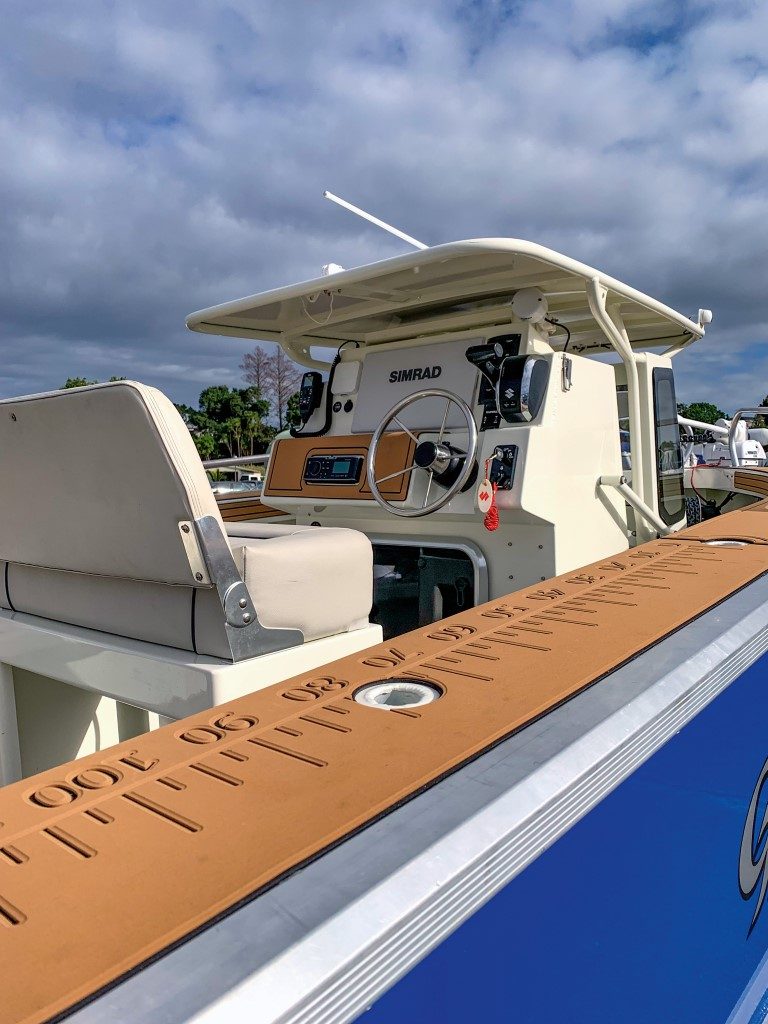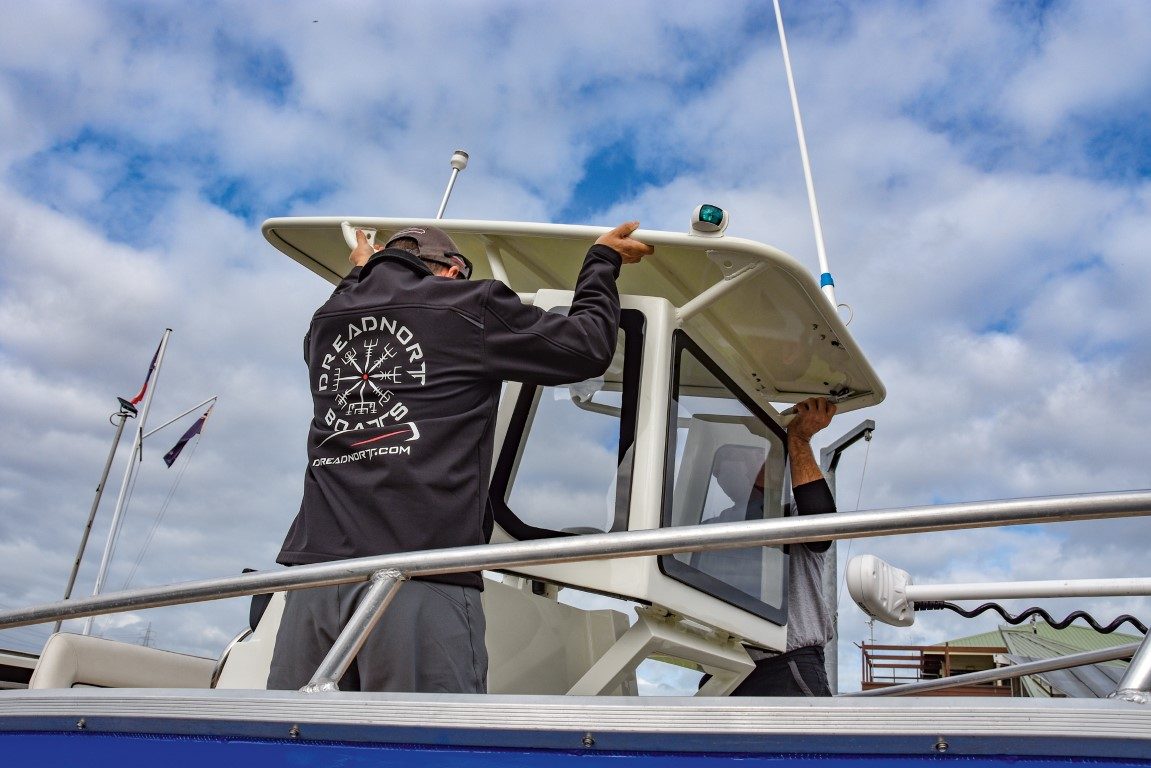‘Behemoth’ is a word which springs to mind or, perhaps more nautically, ‘leviathan’.
- Hull performance
- Fold-down centre console
- Superb fishability
- Amazing interior volume

You can get any trailer boat to slam if you try hard enough, but during our time with the latest offering from the innovative Auckland-based Dreadnort Boats team, banging of any sort was virtually non-existent.
Dreadnort Boats is a collaboration between Naval Architect Blair Lewis and Shipwright Stuart Dawe, who between them have a wealth of commercial and recreational aluminium boat design and fabrication experience.\

Boating reviewed the larger Dreadnort D7500 with its unusual dreadnought bow profile in its March edition. Dreadnort’s smaller V5500 CC (Centre Console) shares many familial design features with that model, including a long waterline length, the performance characteristics of a much bigger boat and an exceptional interior volume. But unlike the D7500, this boat is a centre console with Dreadnort’s ‘V’ (for Vertical) plumb bow profile. While hardly commonplace, plumb bows are becoming increasingly familiar to the New Zealand boating public, as they are increasingly used in local and imported boats both large and small.
A ‘vertical’ plumb bow is certainly less radical than the bow profile on Dreadnort’s D7500, with its reflex-angled entry, but it provides many of the same benefits by maximising waterline length for exceptional interior volume and facilitating a smooth ride.

Gypsy Rose is a highly-spec’d semi-custom V5500 CC model with several customer-driven features, including the Fusion stereo system from the owner’s previous boat and modifications to the Altech Marine custom dual-axle aluminium trailer for easier beach launching and retrieval. The trailer’s spare wheel pivots and locks to become a fifth wheel for the trailer, allowing the boat to be easily retrieved off the beach using a tow rope. Low friction skids on bunks shaped to the hull, rather than rollers, provide better support on the trailer and ensure easy launching and retrieval.
Gypsy Rose’s owner, who runs a successful panel and paint shop, is responsible for the rig’s striking blue and white paint job with silver graphics, including the Suzuki 150hp outboard, now white above the lower unit rather than factory blue. It looks great.
The owner did much of the boat’s fitout himself, including laying U-Deck on the vessel’s wide coamings and along the gunnels, so there have been a few minor departures from the initial design as drawn. For example, Lewis tells me he was a little surprised to see the sub-woofer set into what was meant to be a watertight buoyancy chamber inside the console, something the owner decided upon himself, but there’s no denying the sound quality is great!
 And the bench-style helm seat is taller than the original design and lacks a reversible backrest. That’s because the owner added a utility tray with drink holders above the console, which then interfered with seated visibility through the windscreen, so a taller seat cushion was found. The Minn Kota trolling motor was another late addition to the build, which also necessitated some changes, but more on that later.
And the bench-style helm seat is taller than the original design and lacks a reversible backrest. That’s because the owner added a utility tray with drink holders above the console, which then interfered with seated visibility through the windscreen, so a taller seat cushion was found. The Minn Kota trolling motor was another late addition to the build, which also necessitated some changes, but more on that later.
The overwhelming impression you get from this boat is of space. It’s a much bigger boat inside than any 5.5m trailer boat has a right to be. It feels beamy, although actual beam is only 2.3m, an impression reinforced by high, near vertical sides and lots of freeboard and the boat being widest at floor level. There are substantial aluminium beltings protecting the hull on both sides around the boat’s waistline, as well as wrapped round the hull at the top of the gunwales.
Since the owner loves to fish, Gypsy Rose has been set up to suit. There are five welded rod holders per side, plus two on a transom bait station that features an acrylic cutting board with two-tier shelving underneath. Side pockets run the full length of the boat, offering generous storage for all sorts of items, including fishing rods, and there are large but shallow side lockers opposite the centre console.

The chequerplate foredeck is expansive. It’s ideal for lure casting, with high sides and substantial bow rails providing excellent security, even when the boat is pitching in rough seas. Access between bow and stern is excellent – no need to turn sideways to pass the console – and there’s a single step down into the cockpit amidships, so that any water finding its way onto the deck is quickly directed to the cockpit and, via its large drain, to the sump. A high-capacity bilge pump then sends the water overboard.
Gpysy Rose is notable for her bow set-up. When the owner decided on an electric trolling motor the boat was already nearing completion, so he elected to mount it on the existing bowsprit. Oriented along the boat’s centreline, the electric not only works more efficiently, it also fits snugly under the boat’s road cover – and there was no need to split the bow rail to accommodate it.
With the electric occupying the bowsprit, the anchor set-up had to be moved. A Maxwell drum system is mounted at an angle on top of a small bow compartment (with inset speakers and storage) and the solidly built fairlead is offset to port, angled under the bow rail beside the Minn Kota. And since the owner seldom anchors, when not required, the bowsprit can be removed by pulling a few pins.

The addition of the Minn Kota has also meant that the house and start batteries, originally planned for inside the centre console, have been relocated to the transom locker. Their place in the console is now taken by the trolling motor battery. Although the house and start batteries are well protected, it’s a tight fit inside the transom locker and there are plans to relocate them to the console again just forward of the 200-litre underfloor fuel tank. Relocating the batteries will also benefit the vessel’s centre of buoyancy/balance, says Lewis, which currently runs through the middle of the helm seat.

The centre console design is interesting. The fixed helm seat is fairly conventional (aside from the higher than spec seat base). It comfortably seats two, which the console is wide enough to shelter from wind and spray, and the tall windscreen protects heads from the slipstream. An Icey-Tek chilly bin slides under the helm seat and the owner opted to remove the fixed seat in front of the console so he could carry a second chilly bin. He went for two folding transom seats as well.
The console has plenty of dashboard space – enough for a 15-inch Simrad MFD, VHF radio, Suzuki instruments, switch panels, anchor controls, Fusion stereo and more. The centre console’s party trick is the ability to open a couple of clips and drop the top half down to just above the floor level via a clever pantograph pivoting system. This lowers the vessel’s profile for easier towing and storage. While the pantograph system works a treat, it is quite complex to engineer, so Dreadnort is looking to offer cheaper, less complex alternatives for subsequent boats. This model is also offered as a cuddy cabin.

My afternoon aboard Gypsy Rose comprised a mixture of sunshine and showers, along with a stiff westerly breeze that built as the day wore on. Launching at Te Atatu, we ran down the Waitemata Harbour and around North Head into Rangitoto Channel for the photography. Sea conditions ranged from a bit of wind ripple in the lee close to shore to quite choppy with waves that got bigger and steeper the further out we went. It was a good real-life assessment for the boat.
The conditions turned out to be completely to the Dreadnort’s liking. More to the point, the three of us onboard remained comfortable, even the standing passenger, and the boat proved very dry under most circumstances – the pronounced chine flats probably helped here, as they do with stability at rest.
Ride quality is excellent and, as noted in the opening paragraph, I struggled to make the hull bang, no matter what angles I chose or how big the waves and boat wakes were. It certainly didn’t feel or behave like a 5.5m aluminium trailer boat but gave the impression it was much bigger.

The boat rides on her strakes, travelling with a slightly bow-up attitude, though it is hardly noticeable from the helm. The plumb bow’s fine entry really comes into its own when punching into big, steep waves, cutting through the water and cushioning the impact. The hull is very quiet, with no booming whatsoever.
The impressively hushed Suzuki 150hp gets the boat along nicely enough. Gypsy Rose gets onto the plane smartly – the transition is around 10-12 knots – cruises comfortably at 4400rpm/25 knots and has a top speed of around 34 knots. In the lumpy conditions, we managed 33 knots.
This unusual trailer boat makes quite a statement – on and off the water. Her owner is extremely happy with his new toy, as are his fishing friends, all of whom have commented on Gypsy Rose’s superior ride, amazing interior volume and superb fishability.

Semi-custom alloy boats are not for everyone, but if you are after something a little different and in many ways superior to usual run of sub-6m trailer boats, the Dreadnort V5500 CC could be worth considering. You’ll pay more for the engineering expertise, premium build quality and custom options, but the boat’s superior handling, volume and ride might be all the justification required. Gypsy Rose’s owner thinks so.
/>
‘Behemoth’ is a word which springs to mind or, perhaps more nautically, ‘leviathan’.
White Pointer has earned the respect of discerning customers in New Zealand and Australia, attracting a loyal and ever growing following for its high-quality, rugged and totally dependable aluminium trailer boats.
The hardtop SP635 shares the same underpinnings as the popular SF 635 which was a completely new model back in 2020.
The pride and joy of a multi-generational family, Bliss resides on a pier that’s home to a couple of other Elite motor launches – Sandspit Marina is a hot-spot for the Bill Upfold-designed vessels, with several calling this small marina home.